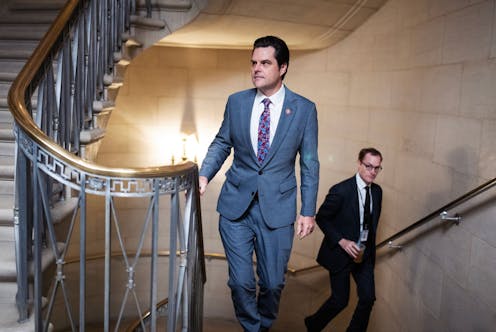Why does the Senate confirm Trump’s picks for key posts — and how? A legal scholar explains the confirmation process and the ‘constitutional loophole’ of recess appointments
- Written by Jennifer Selin, Associate Professor of Law, Arizona State University
 Will Trump nominee Matt Gaetz be able to ascend to the top position at the Justice Department?Tom Williams/CQ-Roll Call, Inc via Getty Images
Will Trump nominee Matt Gaetz be able to ascend to the top position at the Justice Department?Tom Williams/CQ-Roll Call, Inc via Getty ImagesSince Election Day, President-elect Donald Trump has moved quickly to name his picks for key cabinet posts such as attorney general and the secretaries of defense, health and human services, and state.
Reaction to these nominees ranges from excitementto shock, but one thing is clear: Trump seeks a cabinet filled with staunch allies, even if those allies have little experience in government.
The Constitution requires the Senate to confirm each of these nominations.
History shows that, even when the Senate majority and the president are from the same party, the nomination process does not always go according to presidential plan.
The spoils system
When contemplating appointments, the Framers of the Constitution largely focused on the potential for abuse of government power. During the debates over ratification, some raised concerns that the president’s ability to appoint people to executive positions could lead to a dictatorship supported by officials who owed their allegiance to the president.
To address that concern, the Framers designed the appointments clause of the Constitution to require all officers of the United States appointed by the president to be subject to the “advice and consent” of the Senate. The Supreme Court has interpreted this clause to require Senate confirmation of any appointee exercising significant executive authority.
 Roger Taney was the first cabinet nominee to be rejected by the Senate. President Andrew Jackson then named him to the Supreme Court.Fotosearch/Getty Images
Roger Taney was the first cabinet nominee to be rejected by the Senate. President Andrew Jackson then named him to the Supreme Court.Fotosearch/Getty ImagesThe first cabinet official was confirmed in 1789 when the Senate unanimously approved President George Washington’s nomination of Alexander Hamilton to be treasury secretary. Shortly thereafter, the Senate confirmed Washington’s picks for attorney general and the secretaries of war and state.
Before making these nominations, Washington consulted senators to gain their approval.
The tradition of informal consultation with Congress during the nomination process continued for some time but led to controversy as presidents and senators met behind closed doors to trade favors and use appointments for political gain.
This “spoils system” rewarded political loyalists and punished enemies. As New York Sen. William L. Marcy famously declared after Andrew Jackson’s 1828 election, “to the victor belong the spoils of the enemy.”
Battles over confirmation
But soon the tide turned against Jackson. The Senate became increasingly uncomfortable with political patronage when Jackson used his constitutional authority to make appointments during a Senate recess to avoid confrontations with Congress over the Second Bank of the United States. Specifically, Jackson appointed Roger Taney, who was outspoken against the bank and vowed to work to destroy it, as treasury secretary in 1833. When the recess appointment ended in 1834 and Taney was up for reappointment, the Senate rejected the nomination, making Taney the first cabinet nominee not to be confirmed.
Jackson then nominated, and the Senate ultimately confirmed, Taney to the Supreme Court. Taney went on to write the majority opinion in the 1857 ruling in Dred Scott v. Sanford, which held that enslaved people were property who had no constitutional rights.
Battles over cabinet nominations have only increased since then.
One notable confirmation battle occurred over President Dwight Eisenhower’s nomination of Lewis Strauss to be commerce secretary. As depicted in the blockbuster movie “Oppenheimer,” Senate Commerce Committee hearings over the nomination lasted two months and included allegations of government-wide political corruption, antisemitism and questions over the role of science in government. Ultimately, the Senate refused to confirm Strauss.
The last rejection of a president’s nomination was in 1989 when President George H.W. Bush nominated John Tower as secretary of defense. Allegations involving Tower’s alcohol abuse, sex life and financial conflicts of interest led to an FBI investigation that ended without any formal charges. But the inquiry also led to five weeks’ worth of Senate confirmation hearings followed by a 53-47 vote to reject Tower’s nomination.
Getting through the process
Today, rather than face such public scrutiny, presidents are much more likely to withdraw nominations that provoke conflict.
Presidents Bill Clinton, George W. Bush, Barack Obama and Trump all withdrew nominations of cabinet officials when it became clear that the nominations would likely fail.
These withdrawals have been the result of a nomination and confirmation process designed to unearth national security, financial and political concerns over nominees.
After the president identifies the person he would like to serve in a particular position, that person typically goes through a formal investigation by the FBI and the Office of Government Ethics.
The FBI’s investigation usually goes back at least 15 years, depending on the position and extent to which the person will deal with classified information. The findings go directly to the president, but the Senate may request a report summarizing the FBI’s investigation.
Traditionally, these checks are used to vet nominees’ eligibility for a security clearance. However, Trump ignored FBI security concerns about certain nominees in his first administration, and his current transition team is, in some cases, bypassing FBI background checks in favor of vetting by private companies.
A nominee’s financial affairs are reviewed by the Office of Government Ethics, an independent agency designed to prevent and resolve conflicts of interest in government. This process is so complex and time-consuming that most nominees retain lawyers and accountants to help them navigate the process.
During the investigation, nominees may have to sell assets or rearrange their finances to comply with federal laws that govern financial conflicts of interest. At the conclusion of its review of and negotiations with the nominee, the Office of Government Ethics provides the Senate with a report detailing its investigation, negotiations and findings.
However, a year into his first term, at least three of Trump’s cabinet officials refused to fully disclose their assets to the Office of Government Ethics, and one investigative story revealed that more than half of his cabinet allegedly engaged in “questionable or unethical conduct” while in office.
 The FBI has historically conducted background investigations of presidential nominees.Mandel Ngan/AFP via Getty Images
The FBI has historically conducted background investigations of presidential nominees.Mandel Ngan/AFP via Getty ImagesOnce a president officially sends a nomination to the Senate, it goes to the committee that has primary oversight jurisdiction over the department the person would lead. While each committee has its own standards and procedures for processing these nominations, the vetting process is the same.
Committees require the nominee to provide information about their background, as well as some sort of financial statement. Committees then use this information to launch their own investigations. During this process, most cabinet nominees will meet with committee staff and privately with individual senators.
Some committees are renowned for their thoroughness. The Senate Judiciary Committee has staff devoted exclusively to investigation of nominees, and the Senate Finance Committee is known for tracking down inconsistencies in decades’ worth of tax records.
Most cabinet nominees will also face a public hearing where senators will ask about their qualifications, question the nominees’ plans for the agency and highlight any concerns raised by constituents or the media.
What is a recess appointment?
During the constitutional debates in 1787, some were concerned that the need for Senate confirmation would require the Senate to be perpetually in session in order to receive appointments. Given the time and resources required for senators in the 18th century to work in their home states and also conduct business as a group, regular meetings were not feasible.
So the Framers placed a clause in the Constitution that allows presidents to appoint officials when the Senate is in recess. That appointment expires at the end of the Senate’s next session.
Presidents have historically exploited this constitutional loophole. They have used this “recess appointments” power for political gain and to temporarily install people in office who would not otherwise be confirmed by the Senate. However, there is some evidence that the uncertainty and partisan conflict that result from such appointments leads to administration problems.
The Supreme Court reviewed this practice in 2014, when Obama appointed three members of the National Labor Relations Board without Senate confirmation.
The court held the president lacked the power to make such appointments and that a Senate recess has to be at least 10 days long before a president can bypass confirmation. As a result, the Senate now holds pro forma sessions where no business is conducted but the chamber is technically open to prevent a recess appointment.
President-elect Trump has called on the Senate to stop this practice and allow him to make recess appointments. Incoming Senate Majority Leader John Thune has not ruled that out, stating that “all options are on the table, including recess appointments.”
Jennifer L. Selin has received funding and/or support for her research on the executive branch from the Administrative Conference of the United States. The views in this piece are those of the author and do not represent the position of the Administrative Conference or the federal government.
Authors: Jennifer Selin, Associate Professor of Law, Arizona State University

